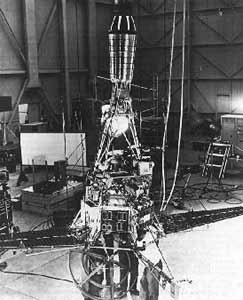Thank you very much for visiting Gunter's Space Page. I hope that this site is useful and informative for you.
If you appreciate the information provided on this site, please consider supporting my work by making a simple and secure donation via PayPal. Please help to run the website and keep everything free of charge. Thank you very much.
Ranger 1, 2 (Ranger Block 1)

Ranger 1 [NASA]
Ranger 1 was a spacecraft whose primary mission was to test the performance of those functions and parts necessary for carrying out subsequent lunar and planetary missions using essentially the same spacecraft design. A secondary objective was to study the nature of particles and fields in interplanetary space.
The spacecraft was of the Ranger Block 1 design and consisted of a hexagonal base 1.5 m across upon which was mounted a cone-shaped 4 m high tower of aluminum struts and braces. Two solar panel wings measuring 5.2 m from tip to tip extended from the base. A high-gain directional dish antenna was attached to the bottom of the base. Spacecraft experiments and other equipment were mounted on the base and tower. Instruments aboard the spacecraft included a Lyman-alpha telescope, a rubidium-vapor magnetometer, electrostatic analyzers, medium-energy range particle detectors, two triple coincidence telescopes, a cosmic-ray integrating ionization chamber, cosmic dust detectors, and solar X-ray scintillation counters.
The communications system included the high gain antenna and an omni-directional medium gain antenna and two transmitters, one at 960.1-MHz with 0.25 W power output and the other at 960.05-MHz with 3 W power output. Power was to be furnished by 8680 solar cells on the two panels, a 57 kg silver-zinc battery, and smaller batteries on some of the experiments. Attitude control was provided by a solid-state timing controller, Sun and Earth sensors, and pitch and roll jets. The temperature was controlled passively by gold plating, white paint, and polished aluminum surfaces.
The Ranger 1 spacecraft was designed to go into an Earth parking orbit and then into a 60,000 × 1,100,000 km Earth orbit to test systems and strategies for future lunar missions. Ranger 1 was launched into the Earth parking orbit as planned, but the Agena B failed to restart to put it into the higher trajectory, so when Ranger 1 separated from the Agena stage it went into a low Earth orbit and began tumbling. The satellite re-entered Earth's atmosphere on 30 August 1961. Ranger 1 was partially successful, much of the primary objective of flight testing the equipment was accomplished but little scientific data was returned.
- Lyman-Alpha Telescope
- Magnetometer
- Electrostatic Analyzer
- 2 Charged Particle experiments
- Cosmic Ray
- Cosmic Dust
- Scintillation Counters
The Ranger 2 spacecraft was launched into a low earth parking orbit, but an inoperative roll gyro prevented Agena restart. The spacecraft could not be put into its planned deep-space trajectory, resulting in Ranger 2 being stranded in low earth orbit upon separation from the Agena stage. The orbit decayed and the spacecraft reentered Earth's atmosphere on 20 November 1961.
- Lyman Alpha Telescope
- Rubidium Vapor Magnetometer
- Electrostatic Analyzer
- Medium Energy Particle Detectors
- Triple Coincident Telescope
- Cosmic Ray Ion Chamber
- Cosmic Dust Detectors
- Scintillation Counter
| Nation: | USA |
|---|---|
| Type / Application: | Interplanetary technology development |
| Operator: | NASA |
| Contractors: | Jet Propulsion Laboratory (JPL) |
| Equipment: | |
| Configuration: | |
| Propulsion: | ? |
| Power: | 2 deployable fixed solar arrays, batteries |
| Lifetime: | |
| Mass: | 304 kg |
| Orbit: | 179 km × 446 km, 32.9° (#1) |
| Satellite | COSPAR | Date | LS | Launch Vehicle | Remarks | |
|---|---|---|---|---|---|---|
| Ranger 1 (P 32) | 1961 φ 1 | 23.08.1961 | CC LC-12 | P | Atlas-LV3 Agena-B | |
| Ranger 2 (P 33) | 1961 αθ 1 | 18.11.1961 | CC LC-12 | P | Atlas-LV3 Agena-B |
